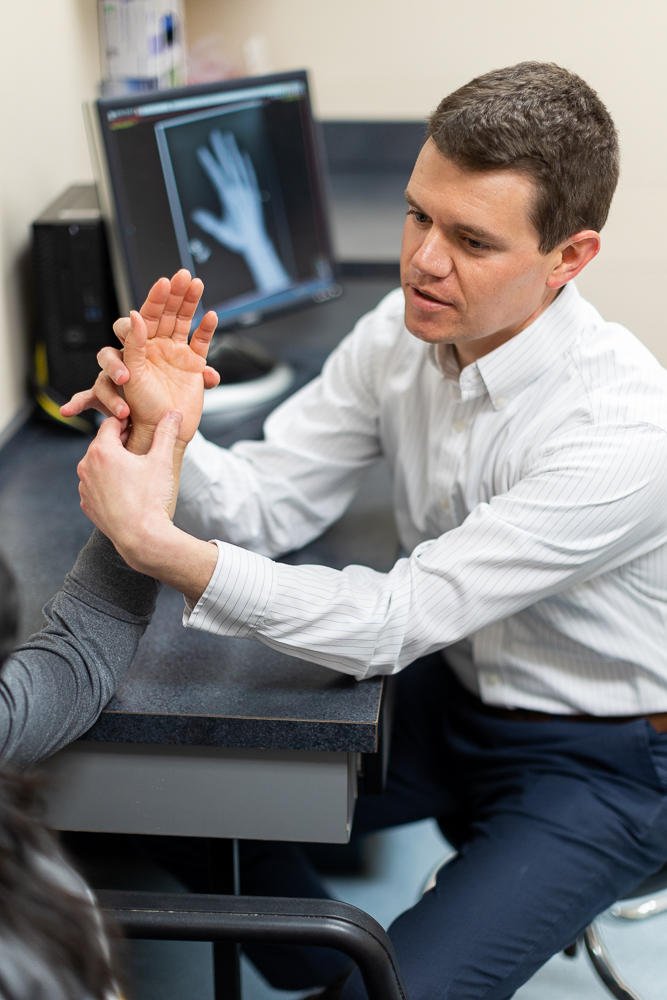
No matter how cautious you are, there’s no way to completely eliminate injury risk from your life.
Although Kansas City Orthopedic Alliance providers are always prepared to help when patients need treatment, we want to see everyone live pain-free lives above anything else. Actively taking steps to reduce your injury risk and mitigate any potential damage is an effective way to do so.
Read on to learn some helpful tips for preventing common hand and wrist injuries, provided by a KCOA orthopedic specialist in Kansas City!
Use Correct Gear
Whether you spend hours performing physical activity or working on a computer, having the right protective equipment can greatly reduce injury risk. Wearing a well-padded, well-fitting pair of gloves or wrist guards can help you lessen, or even avoid, impact from an acute injury while on the job or on the field.
If you sit in a stationary position for most of your day, consider purchasing some equipment that helps improve your hand and wrist posture. One of the most popular items in this category are ergonomic keyboards. Taking steps to improve your posture and technique will help you avoid repeated stress and inflammation in the area.
Improve Your Bone Strength
Good bone strength helps tremendously with reducing the symptoms and effects of hand and wrist injury. One of the best ways to improve your bone strength is by consuming more calcium in your diet, roughly 1,000-1,200mg per day depending on your age.
Your bones naturally start to become more brittle as you age, and because your body doesn’t naturally produce calcium, it makes a calcium-rich diet all the more important. Not only does calcium improve bone strength, however, it also helps improve blood circulation and muscle control!
Stay Hydrated & Stretch Regularly
What does water have to do with injury prevention? More than you might think! Your body needs water to function properly, and that includes your hands and wrists. Dehydration can lead to issues such as muscle fatigue and tendonitis, while drinking proper amounts of water can improve joint health.
Similarly, stretching is as important for your hands and wrists as it is for your whole body. Stretching periodically throughout the day can help your muscles and joints maintain their proper flexibility and range of motion, while preventing tightness and weakness.
Minimize Potential Hazards
Some acute injuries in particular are just bad luck. We can’t control what other people will do, and there’s only so much you can change about the world around you. However, there are several small steps that you can do to help minimize risk in your daily life. Some examples from our hand doctor in Kansas City include:
- Minimizing your distractions, so that you can maintain focus on your surroundings
- Be careful when shutting doors. windows, etc., and make sure that your hands/wrists are clear of potential contact.
- Wear well-fitting protective gear like gloves, when working in situations where the risk for hand and wrist injuries is higher.
- Hold your hand away from potential dangers (like when cutting food or using power tools).
- Install rails and bars where necessary to reduce the risk of falls in your home.
- In the event you do start to fall, try to avoid falling on your outstretched hand. Lean into the fall to give yourself control and try to fall sideways into the softest area possible.
Searching for an Orthopedic Hand Specialist in Kansas City? Contact KCOA Today!
At Kansas City Orthopedic Alliance, we’re dedicated to creating a superior patient experience for all. Regardless of the location or severity of your hand or wrist injury, our team will work with you to ensure the best possible outcome.
Request an appointment with one of our providers to find the best treatment option for your needs. You can also receive a thorough evaluation, by calling (913) 319-7600 or by using our symptom tracker tool. If you have any additional questions or comments, feel free to fill out our contact form to get a prompt response from a KCOA representative.


